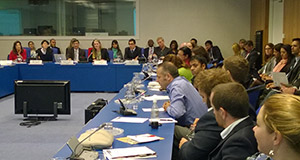Vienna, 27 October 2014, UNODC.
This post was originally published on the UNODC website.
Transnational organized crime is fuelled by corruption. Criminal networks use bribes to facilitate the trafficking of people, drugs, endangered species and arms. In addition, environmental crimes such as illegal logging are often enabled through illicit payments to relevant officials in order to ensure their cooperation.

Q&A session
To illustrate these phenomena, four representatives of Non-Governmental Organizations (NGO) presented their points of view at a side event organised on 8 October 2014 by the UNODC Civil Society Team on the margins of the seventh session of the Conference of the Parties to the United Nations Convention against Transnational Organised Crime (CTOC/COP7) – “Addressing the Links between Corruption and Transnational Organised Crime”.
Representatives of NGOs, United Nations bodies and Member States delegates showed considerable interest in hearing the views of the NGO speakers, with over 70 participants attending the side event.
H.E. Susan Le Jeune D’Allegeershecque, Ambassador of the United Kingdom of Great Britain and Northern Ireland (UK) to the United Nations Office at Vienna moderated the side event. Ambassador D’Allegeershecque mentioned that the UK attached great importance to civil society participation in the work done by UNODC, including that against corruption and transnational organised crime. Also, the Ambassador recalled a speech recently made by Prime Minister David Cameron. Speaking at a side event on the margins of the 69 th session of the General Assembly, Prime Minister Cameron stated that the fight against corruption should be one of the sustainable development goals for the post-2015 agenda.
Mr. Manzoor Hasan, Chair of the UNCAC Coalition, Barrister-at-Law and Executive Director of the South Asian Institute of Advanced Legal and Human Rights Studies – SAILS presented a study undertaken in seven constituencies in Bangladesh on local power structures. Mr. Hasan highlighted the connections between the mastaans (‘mafia’), politicians and youth leaders in land grabbing, drug dealing and extortion cases.
Ms. Anna Alvazzi del Frate, Research Director at Small Arms Survey – SAS, underlined that corrupt officers and loopholes in authorised transfers play a large role in helping divert surplus small arms and ammunition. Through the Transparency Barometer, Ms. Alvazzi del Frate illustrated a direct correlation between the export of illicit arms and anti-corruption measures.
Mr. Joel Jabiles, Project Coordinator, Capital Humano y Social Alternativo – CHS Alternativo and member of the Global Alliance against Traffic in Women – GAATW presented research on the links between corruption and human trafficking in Peru. He showed how poverty, informal economy and increased demand for sexual and labour exploitation are reinforced by corruption. Through cross-referencing the results of the Transparency International Corruption Perceptions Index 2013 and those of the U.S.A. Trafficking in Persons Report 2013, evidence was presented on the nexus between corruption and human trafficking at global level.
Finally, Mr. Julian Newman, Campaign Director at the Environmental Investigation Agency – EIA, portrayed the mutually supportive relation between corruption and environmental crime, giving examples from EIA investigations in Indonesia, Laos, Mozambique and Vietnam.
The questions and answers session focused on the important role that education and media, in particular social media, can play in the fight against corruption and transnational organised crime.
Presentations
- The Real Politics of Bangladesh
- Corruption and small arms
- Human Trafficking and Corruption in Peru
- Corruption in Wildlife and Forest Crime
Flyer and UNCAC Coalition Tweet
- Flyer
- Congrats to @UNODC Civil Society Team on excellent #UNTOC side event today on “Addressing the links between #corruption and organized crime” – UNCAC Coalition (@uncaccoalition) October 8, 2014



